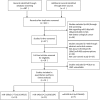Association between Polymorphisms in MicroRNAs and Risk of Urological Cancer: A Meta-Analysis Based on 17,019 Subjects
- PMID: 28579964
- PMCID: PMC5437731
- DOI: 10.3389/fphys.2017.00325
Association between Polymorphisms in MicroRNAs and Risk of Urological Cancer: A Meta-Analysis Based on 17,019 Subjects
Abstract
Accumulating evidence has demonstrated that some single nucleotide polymorphisms (SNPs) existing in miRNAs correlate with the susceptibility to urological cancers. However, a clear consensus still not reached due to the limited statistical power in individual study. Thus, we concluded a meta-analysis to systematically evaluate the association between microRNA SNPs and urological cancer risk. Eligible studies were collected from PubMed, Embase, Web of Science, and CNKI databases. Pooled odds ratio (OR) and corresponding 95% confidence interval (95% CI) were calculated to assess the strength of the relationships between three SNPs (miR-196a2, C>T rs11614913; miR-146a, G>C rs2910164; and miR-499, A>G rs3746444) and the risk of urological cancers. In addition, the stability of our analysis was evaluated by publication bias, sensitivity and heterogeneity analysis. Overall, a total of 17,019 subjects from 14 studies were included in this meta-analysis. We found that CT (miR-196a2, C>T rs11614913) was a risk factor for renal cell carcinoma (CT vs. CC: OR = 1.72, 95%CI = 1.05-2.80, P = 0.03, I2 = 66%), especially in Asian population (CT vs. CC: OR = 1.17, 95%CI = 1.04-1.32, P < 0.01, I2 = 0%). miR-146a G>C rs2910164 was a protective factor of urological cancers (C vs. G: OR = 0.87, 95%CI = 0.81-0.93, P < 0.01, I2 = 0%), especially for bladder cancer. miR-499 A>G rs3746444 was correlated with an increased risk of urological cancers, specifically in Asian population. In conclusion, our meta-analysis suggests that polymorphisms in microRNAs, miR-196a2, C>T rs11614913, miR-146a G>C rs2910164 and miR-499 A>G rs3746444, may be associated with the development of urological cancers and the risks mainly exist in Asian populations.
Keywords: meta-analysis; microRNA-146a; microRNA-196a2; microRNA-499; polymorphism; urological cancers.
Figures







Similar articles
-
Study of the association between five polymorphisms and risk of hepatocellular carcinoma: A meta-analysis.J Chin Med Assoc. 2017 Apr;80(4):191-203. doi: 10.1016/j.jcma.2016.09.009. Epub 2017 Feb 8. J Chin Med Assoc. 2017. PMID: 28188097
-
The association between two common polymorphisms (miR-146a rs2910164 and miR-196a2 rs11614913) and susceptibility to gastric cancer: A meta-analysis.Cancer Biomark. 2015;15(3):235-48. doi: 10.3233/CBM-150470. Cancer Biomark. 2015. PMID: 26406571
-
Impacts of single nucleotide polymorphisms in three microRNAs (miR-146a, miR-196a2 and miR-499) on the susceptibility to cervical cancer among Indian women.Biosci Rep. 2019 Apr 16;39(4):BSR20180723. doi: 10.1042/BSR20180723. Print 2019 Apr 30. Biosci Rep. 2019. PMID: 30872409 Free PMC article.
-
The association of common functional polymorphisms in mir-146a and mir-196a2 and hepatocellular carcinoma risk: evidence from a meta-analysis.Medicine (Baltimore). 2014 Dec;93(29):e252. doi: 10.1097/MD.0000000000000252. Medicine (Baltimore). 2014. PMID: 25546664 Free PMC article. Review.
-
Genetic variations in MicroRNA genes and cancer risk: A field synopsis and meta-analysis.Eur J Clin Invest. 2020 Apr;50(4):e13203. doi: 10.1111/eci.13203. Epub 2020 Mar 6. Eur J Clin Invest. 2020. PMID: 31984489 Review.
Cited by
-
Association of mir-196a-2 rs11614913 and mir-149 rs2292832 Polymorphisms With Risk of Cancer: An Updated Meta-Analysis.Front Genet. 2019 Mar 15;10:186. doi: 10.3389/fgene.2019.00186. eCollection 2019. Front Genet. 2019. PMID: 30930933 Free PMC article.
-
Impacts of Mir146a Genotypes on Bladder Cancer Risk in Taiwan.Biomedicines. 2023 May 8;11(5):1396. doi: 10.3390/biomedicines11051396. Biomedicines. 2023. PMID: 37239070 Free PMC article.
-
Role of Non-Coding RNAs in the Etiology of Bladder Cancer.Genes (Basel). 2017 Nov 22;8(11):339. doi: 10.3390/genes8110339. Genes (Basel). 2017. PMID: 29165379 Free PMC article. Review.
-
A Meta-Analysis of miR-499 rs3746444 Polymorphism for Cancer Risk of Different Systems: Evidence From 65 Case-Control Studies.Front Physiol. 2018 Jun 12;9:737. doi: 10.3389/fphys.2018.00737. eCollection 2018. Front Physiol. 2018. PMID: 29946268 Free PMC article.
-
Polymorphisms in miRNA genes play roles in the initiation and development of cervical cancer.J Cancer. 2019 Aug 20;10(20):4747-4753. doi: 10.7150/jca.33486. eCollection 2019. J Cancer. 2019. PMID: 31598146 Free PMC article.
References
-
- Chirila D. N., Popp R., Vesa S., Balacescu O., Coman I., Constantea N. A., et al. (2015). GSTM1, GSTT1 and GSTP1 genetic variants in multiple urologic cancers. Chirurgia (Bucur) 110, 254–261. - PubMed
LinkOut - more resources
Full Text Sources
Other Literature Sources

